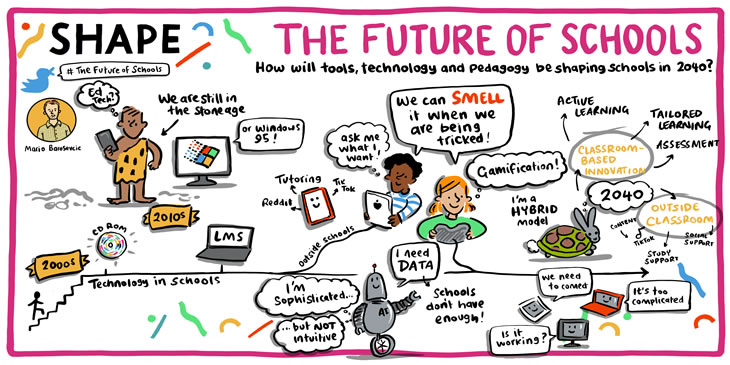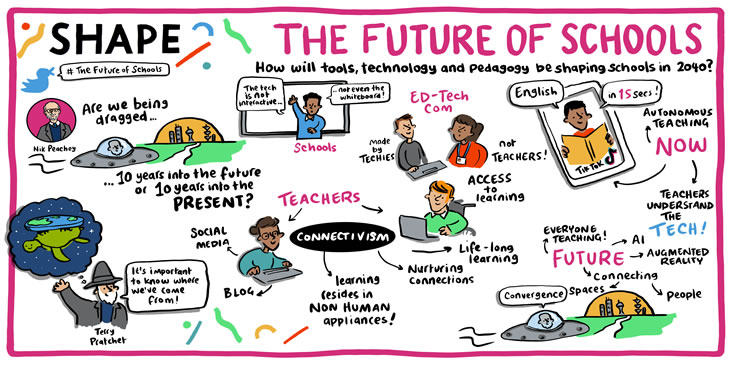On the penultimate day of SHAPE Education: The Future of Schools, educational technology took centre stage. Mario Barosevcic, Nik Peachy, Gisella Langé, and Jason Tan gave talks and discussed the role they see technology playing in education by 2040. The talks and conversations covered a wide range of topics including: the pedagogy in educational technology, the value of connecting through technology, the need to reflect on how technology can make education more accessible, and participatory approaches to developing educational technology.
The potential of education technology

Mario opened the talks on technology stating that “we are really still in the stone age of edtech”. While he acknowledged that there has been a lot of progress, with the development of learning management systems that can foster the “democratisation” of education for example, largely, he argued that technology developments have served institutions and ways of working with little concern for advancing learning. His vision of the future of technology and pedagogy is one in which developers engage with learners as end users, move towards simplified, transparent, and connected technologies, and, crucially, base their decisions on pedagogical knowledge and expertise. To move forward with technology, Mario said we need to be realistic, and he thought that active learning, tailored learning, and “assessment on the go” present opportunities to really make the most of digital pedagogies. In reflecting on the past to consider the future, Mario closed his talk, stating that we have “a long way to go in terms of catching up with the potential of technology for 2021, and there is a lot more potential for 2040”. To find out more about Mario’s vision of the future of educational technologies, you can check out his talk.
Technology and pedagogy: A new future or a return to the past?

Nik’s talk picked up on many of the ideas that Mario discussed. He talked about how uneven the development of digital pedagogies has been. For example, he saw the pandemic dragging many practitioners in education “10 years forward into the present” and doing work that others have been doing for many years. Nik saw schools, edtech companies, and teachers at the centre of educational technology developments, and echoed Mario’s point that much of the use of technologies so far has been ineffective and has added little of value to learning and pedagogy. Nik also saw much potential in technology for developing autonomous learning and for connecting people. In fact, he stated that connectivism will be “a very important theory of learning going forward” and, like Silvana Richardson on day three of the event, he argued that nurturing and maintaining connections is needed to facilitate continual learning. In closing the talk, Nik questioned the role that technology will play in education in 2040. Over the next 20 years, will we drive forward or go back to normal? He hoped to see more and more development, but pointed out that this will not happen without effort from stakeholders at every level. For more on Nik’s vision of the future of technology and pedagogy, watch his talk.
In responding to Mario and Nik, Gisella and Jason spotlighted on different aspects of the talks. Gisella thought that the future of education will make use of technology, but will be shaped by curriculum changes, like competence-based learning, echoing Raya Bidshahri’s presentation on day two. But, she also noted that schools, as places, will still be really important. This is because, like Teocah Dove discussed on day one, limited access and poor connections have already caused learning loss in her country owing to a lack of resource. So, in Gisella’s view, “our conversation should not be how to better develop new tools but how to better use the tools in order that everyone can have access”. Jason also highlighted just how early on we are in this journey with educational technology, and pointed to exciting changes whereby curriculum development can be taken out of the hands of small numbers of policy developers. During the event, the attendees were polled with the following question and possible answers:
Where will learners of the future think of when they need to learn?
- school
- materials provided through school
- online platforms like YouTube, Netflix
- platforms/places children create themselves
- other.
The majority of attendees chose “platforms/places children create themselves” and Jason reflected on this, pointing to his participatory approach to building technology and curricula with teachers, parents, and learners. The conversation that followed delved deep into the role that technology may play in the future of education, so if you’re interested, check out the fireside chat and look out for our final blog discussing the last day of the event.
SHAPE Education is an initiative supported by Cambridge University Press & Assessment and Cambridge Judge Business School.